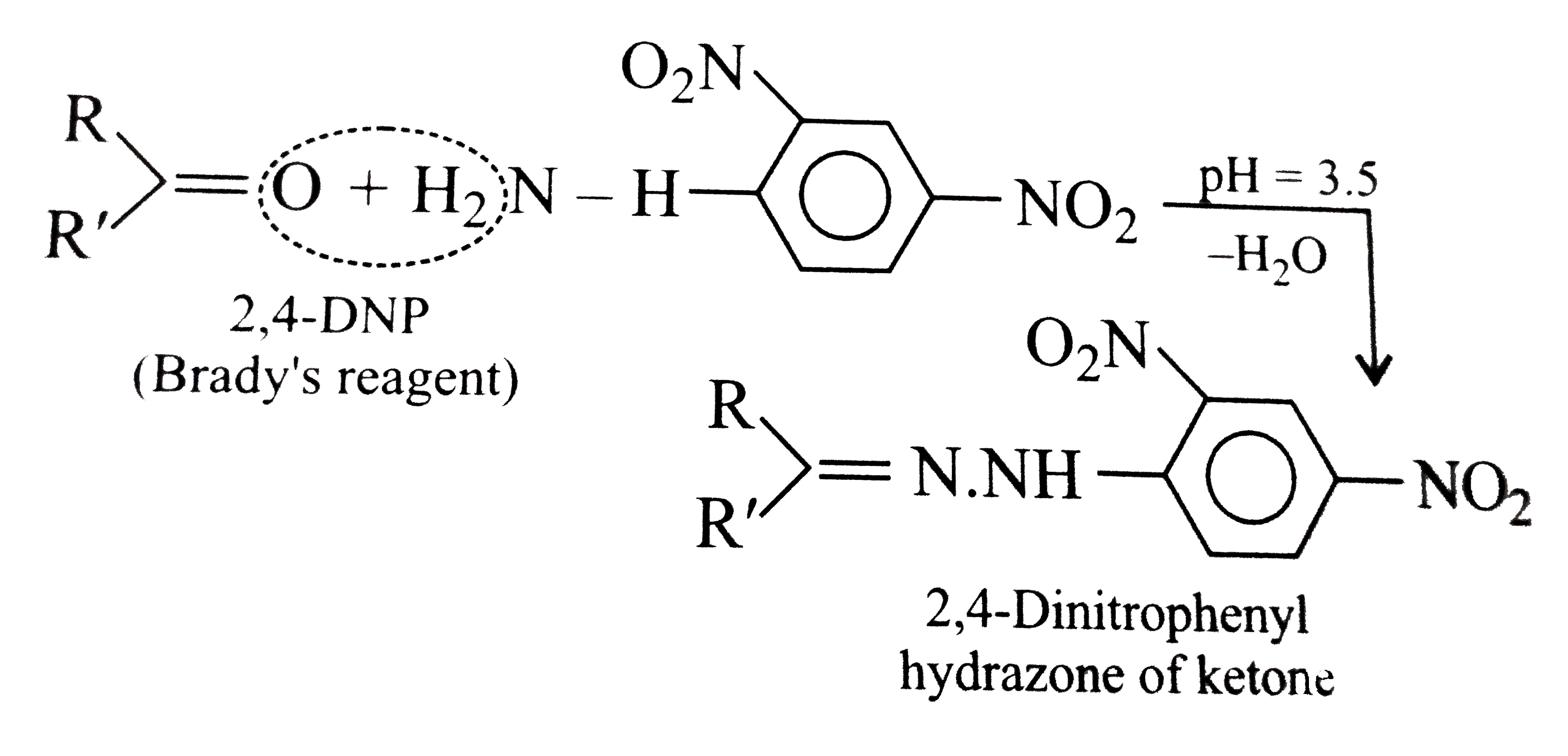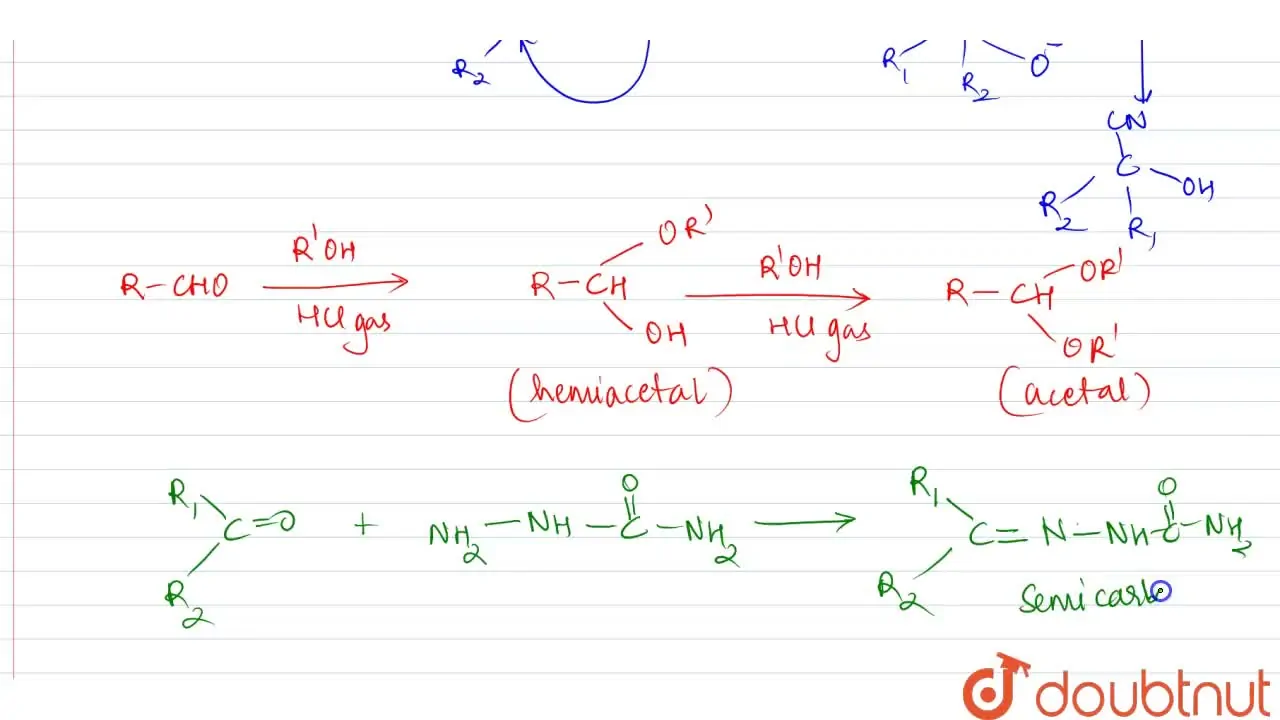What is meant by the following terms ? Give an example of the reaction in the case.
i. Cyanohydrin ii. Acetal
iii. Semicarbazone
i. Cyanohydrin: Compounds containing (OH) group and (CN) group on the same C atom are called cyanohydrin or gem-hydroxy nitriles. They are obtained by the addition of HCN to carbonyl compounds in weakly basic medium.

They are used to prepare α-hydroxy acid, e.g., lactic acid.
ii. Acetal: Compounds containing two alkoxy (OR) groups on the same C atom are called acetal or gem-dialkoxy compounds. They are obtained by the reaction of aldehydes with 2 mol of monohydric alcohol in the presence of dry HCI gas.

They are hydrolysed easily in acidic medium to regenerate original aldehydes. Hence, they are used to protect aldehyde group in the synthesis of various organic compounds.
iii. Semicarbazone: They are ammonia derivaties of carbonyl compounds and are obtained by the reaction of semicarbazide with carbonyl compounds in weakly acidic medium. They are used for the identification and characterisation of carbonyl compounds.

iv. Aldol: Aldol is an abbreviation of aldehyde and alcohol. It is a β-hydroxycarbonyl compound obtained by the condensation of an aldehyde or a keton.
v. Hemiacetal: Compounds containing one alkoxy group (OR) are called hemiacetal or gem-alkoxy alcohols. They are obtained by the addition of 1 mol of a monohydric alcohol to an aldehyde in the presence of dry HCI gas.

vi. Oxime: Oximes are obtained when carbonyl compounds react with hydroxyl amine (H2N−OH) in weakly acidic medium.

vii. Ketal: Compounds containing two alkoxy groups (OR) on the same C atom with the chain are called ketal or gemdialkoxy alkanes. They are obtained when a keton is reacted with dihydric alcohol (e.g., ethylene glycol) in the presence of dry HCI gas or p-toluene sulphonic acid.

They can be easily hydrolysed in acidic medium to regenerate the original ketone, hence it can be used for the protection of (C==O) group.
viii. Imine: Compounds containing (−CH==N−) groups are called imines. They are obtained when carbonyl compounds react with ammonia derivatives.

ix. (2,4-DNP derivatives): They are produced when carbonyl compounds reacts with 2,4-dinitrophenyl hydrazine in weakly acidic medium.

2,4-DNP reagent is used as a testfor (C=O) group since they give coloured compounds (red, orange, or yellow precipitate).
x. Schiff's base: Carbonyl componds react with 1∘ aliphatic or 1∘ aromatic amines to form azomethines or Schiff's bases.

Related Playlists
- BOOK - CENGAGE CHEMISTRY ENGLISHCHAPTER - ALIPHATIC AND AROMATIC ALDEHYDES AND KETONESEXERCISE - Exercises Linked Comprehension59videos
ALIPHATIC AND AROMATIC ALDEHYDES AND KETONES
- BOOK - CENGAGE CHEMISTRY ENGLISHCHAPTER - ALIPHATIC AND AROMATIC ALDEHYDES AND KETONESEXERCISE - Exercises Multiple Correct33videos
ALIPHATIC AND AROMATIC ALDEHYDES AND KETONES
- BOOK - CENGAGE CHEMISTRY ENGLISHCHAPTER - ALIPHATIC AND AROMATIC ALDEHYDES AND KETONESEXERCISE - Exercises Subjective52videos
ALIPHATIC AND AROMATIC ALDEHYDES AND KETONES
- BOOK - CENGAGE CHEMISTRY ENGLISHCHAPTER - ALCOHOL,PHENOL AND ETHERSEXERCISE - Archives Analytical And Descriptive15videos
ALCOHOL,PHENOL AND ETHERS
- BOOK - CENGAGE CHEMISTRY ENGLISHCHAPTER - APPENDIX INORGANIC VOLUME 2EXERCISE - Short Answer Type179videos
APPENDIX INORGANIC VOLUME 2
Similar Questions
What is meant by the following term ? Give an example of the reaction in each case.
CyanohydrinView SolutionWhat is meant by the chelate effect? Give and example.
View Solution(a) What is meant by the following terms ? Give an example of the reaction in each case. (i)Aldol (ii)Semicarbazone
(b) Complete the following :
(i) CH3COClH2Pd−BaSo4−−−−−−−−→
(ii)CH3−CH=CH−CNDIBAl−H−−−−−−→
 View Solution
View SolutionWhat is meant by structural isomerism ? Give an example.
View SolutionWhat is meant by asymmetric synthesis ? Give an example.
View SolutionWhat is meant by promoter ? Give an example.
View SolutionWhat is meant by circular motion? Give one example.
View SolutionWhat is meant by sex-linked inheritance ? Give few examples in man.
View SolutionWhat is hemiacetal form ? Give an example in each case ?
View SolutionWhat is meant by the term retardation ? Name its S.I. unit.
View Solution


